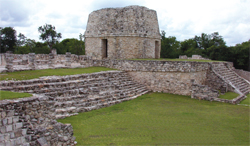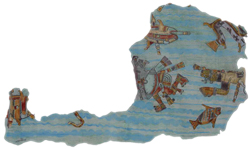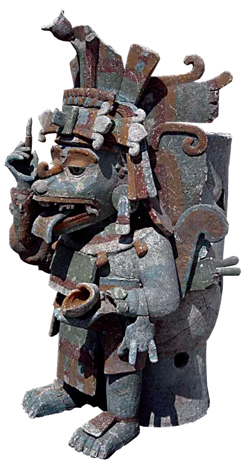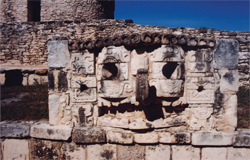
Photo by Susan Milbrath
Atlantean columns with the heads lopped off are evidence of a catastrophic revolt at Mayapan. Archaeologists from the Carnegie Institution never found the heads when excavating the city some 50 years ago. These extraordinary heads are among many artistic treasures that have come to light in recent excavations of Mexico’s last Maya capital. Such fine artworks would have surprised Carnegie archaeologists. After years of work in the 1950s, the Carnegie project found only artworks of inferior quality and buildings that had lost most of their decorative surfaces. They came within inches of finding beautiful murals depicting a mysterious underwater world, but they missed the side chamber of the temple (Q95) when they trenched straight through to the altar. The altar offerings they hoped to find were elusive. Most altars were virtually barren, having been sacked by looters during a revolt that brought an end to Mayapan around A.D. 1450.
Carnegie archaeologists did not realize that art treasures that could not be carried away or mutilated had been purposefully covered over with several coats of plain stucco, essentially erasing traces of the last lords of Mayapan. This helped preserve vividly colored paintings such as the murals in Q95, more aptly renamed the Temple of the Fisherman. The side chamber of this temple depicts a god with a giant shell floating in a watery world with speared trigger fish, a bound crocodile, and a spectacular sea snake. The scene looks like a fisherman’s paradise. Other recently discovered murals are equally intriguing. Mayapan must have been a city of painters.
The vibrant and eclectic nature of Mayapan’s art is only now coming to light. After the Carnegie project completed its work in 1962, Mayapan remained largely ignored for decades. Archaeologists under the direction of Carlos Peraza, began extensive restoration in 1996 to make the city a destination for tourists coming from Merida, now only an hour away on a new highway. Investigating areas not previously excavated, the team made a number of important finds, including many of the long-lost stucco heads of the atlantid figures from Q163, also known as the Hall of Columns. These life-sized heads are startling in their naturalism and have iconographic details that seem more Aztec than Maya. The Carnegie archaeologists had discovered a number of stone sculptures with an Aztec flavor, but these seem crude by comparison.
What brought the Aztecs from highland Central Mexico to lowland Yucatan more than a thousand miles away? The chronicles tell us that the Aztecs had an outpost nearby at Xicalango, on the coast of Campeche. The last Maya rulers of Mayapan, the Cocoms, had invited “Mexicans” to live in the city, in order to gain wealth from trade and provide military support. Friar Diego de Landa, writing in 1566, noted that “Governor Cocom began to covet riches and for this reason he arranged with the troops of the garrison, which the kings of Mexico kept in Tabasco and Xicalango, to hand over the city to them… And the lords would have put him to death, but for fear they had of the Mexicans” (in Landa’s Relación de las cosas de Yucatán).

Photo by Anne Deane
Landa mentions that Yucatan exchanged salt, cloth, and slaves for cacao and stone beads, with Mexican traders from Tabasco and Xicalango. Except for a relatively small number of beads, many found among the scattered materials of looted altars, there is little evidence of such trade in the archaeological record of Mayapan. Cacao, a chocolate bean that was a form of currency in Mesoamerica, would have been carried away. Trade in ceramics and other nonperishables goods is usually the litmus test of contact between distant areas of Mesoamerica. At Mayapan trade goods indicating contact with highland areas to the west include copper bells imported from Oaxaca but no trade ceramics. There are, however, modeled censers with figures that seem inspired by Central Mexican deities. Mixteca-Puebla style murals at Mayapan, such as the Temple of the Five Niches seem closely related to the Mixtec Codex Nuttall. Possibly the designs were modeled on Mixteca-Puebla painted books later destroyed by the Spanish. Such codices could also have inspired Aztec style art at Mayapan. Several structures at Mayapan incorporate artworks that seem to point to contact with Central Mexico.
A different style is evident in the Temple of the Five Niches (Q80), one closely related to Postclassic Mixteca-Puebla murals and polychrome ceramics. This “international style” displays more dense compositions with symbols designed to be understood across language barriers, allowing the Maya, Mixtec, and Nahua peoples to share the broader Mesoamerican traditions. Mixteca-Puebla murals are seen at Mixtec sites in Oaxaca, and the Nahuatl-speaking cities in Puebla and Tlaxcala, as well as at Maya coastal sites like Tulum in Quintana Roo, Mexico and Santa Rita in Belize. Murals the Temple of the Fisherman (Q95) combine Mixteca-Puebla and Postclassic Maya motifs, such as a bound crocodile like that of the Paris Codex and a sea snake resembling the Chicchan Serpent of the Codex Madrid. In contrast, the murals in the Hall of Sun Disks seem to have a distinctively Aztec style. Striding profile figures, rendered in simple, elegant lines, flank a central design (the sun disk), an arrangement seen repeatedly in Aztec relief sculpture.
The chronology of Mayapan’s monumental art suggests that Aztec style is a late veneer at Mayapan, confirming Landa’s account that the Mexicans were late arrivals at Mayapan. The Hall of Sun Disks (Q161), with sun disks and figures resembling those from Central Mexico, is among the latest additions to the principal pyramid (Q162) in the central plaza. The murals in this structure seem designed to please Aztec tastes. They resemble murals from Phase II at the Templo Mayor, the heart of the Aztec capital of Tenochtitlan.
Mayapan supplied the Aztecs with a rare pigment made of indigo combined with a rare clay found only in the area of Mayapan. Maya blue was used in Aztec murals as early as Phase II of the Templo Mayor (A.D. 1375-1427), dating roughly contemporary with late Mayapan murals. Maya blue, used so lavishly in the murals and ceramics of Mayapan, helps explain why the Aztecs originally became interested in trade with this area of Yucatan.
What began as a trade relationship with the Mexicans turned into something more, because the Cocoms began to control Mayapan by force, using the Mexicans as mercenaries. To oust the oppressors, the Xius led a dramatic revolt described by Landa, resulting in the murder of all the Cocom princes, save one who was on a distant trading expedition to Honduras. Landa attributed the Xiu revolt to the tyranny of the Cocom ruler who “introduced more Mexicans into the city.” After the Xius took over the city in Katun 8 Ahau (A.D. 1441-1480), they remained in residence for awhile. The chronicles tell us a pestilence spread through the Xiu community forcing them to finally abandon the city in Katun 4 Ahau (A.D.1480-1500).

Photo by Phil Hofstetter
The eclectic style of Mayapan’s art and architecture seems to reflect the cosmopolitan nature of the city, one of the few true cities in Precolumbian Yucatan. Provincial rulers came from all over Yucatan to reside at Mayapan, and their polities provided food and goods for the city. Mayapan housed between 12,000 and 20,000 people within its 9-km long walled enclosure. Beyond this area, dense settlement tapered off, but clearly the city was supported by a larger population base beyond the fortified walls, an area currently being explored in a project headed by Marilyn Masson and Carlos Peraza.
The architecture of Mayapan indicates an intriguing transformation of Terminal Classic Maya styles. In addition to the Puuc style structures, two buildings (Q152, Q162) loosely replicate important structures at Chichen Itza, a Maya city that had dominated Yucatan between A.D. 800-1050/l100. This style of architecture may relate to the Cocom tradition, linked with a group by the same name referred to in hieroglyphic records at Chichen Itza. The Cocoms of Mayapan apparently traced their heritage to Chichen Itza.
Various chronicles suggest that a group from Chichen Itza founded Mayapan. Analysis of the ceramics at Mayapan and Chichen Itza suggests that there was a brief period of overlap, when Chichen was in decline and monumental construction had largely ceased. Shortly after A.D. 1050/1100, people at Chichen Itza began to make Hocaba ceramics like those found in the first levels of construction at Mayapan, including the early plaza floors beneath the Castillo. The Chilam Balam books tell us that a contingent from Mayapan, led by Hunac Ceel, finally destroyed Chichen Itza.
The earliest known structure at Mayapan was a round platform (Q84) that may have been inspired by round structures first introduced in Yucatan during the Terminal Classic period. This was the first of a series of round structures constructed at Mayapan. One of the latest (Q152)seems to be a replica of Chichen Itza’s Caracol. The Carnegie project had left the structure untouched—perhaps because the building had completly collapsed in the 19th century after being struck by lightning. In the mid 16th century, Landa noted that this round building had four doors, but Carnegie archaeologists presumed that the building had only one door, like other round buildings they had excavated at the Mayapan. It now appears that Landa was correct after all. This should not surprise us, for Landa has proved to be a far better source than anyone imagined. Landa’s alphabet, long ridiculed, is now known to be a set of phonetic sounds that provided a key to deciphering Maya hieroglyphic writing.
Friar Landa also noted that the builders of Mayapan designed their largest pyramid to be a replica of one at Chichen Itza, and both were named the Temple of Kukulcan. The Castillo (“castle”) is a Spanish name also used to designate both of these pyramids. Mayapan’s Castillo (Q162) is a very close copy, although somewhat smaller than the one at Chichen Itza. Landa says that the legendary culture hero Kukulcan, the “feathered serpent” (Quetzalcoatl in Nahuatl), reigned at Chichen Itza and then founded Mayapan before returning Central Mexico. Archaeologists suggest that Chichen Itza’s main occupation (Sotuta phase) reflects a cult of the feathered serpent spread along trade routes from the Central Mexican highlands to the lowland Maya area. Central Mexican sources link Quetzalcoatl with the cult of Venus.
In 2001, I worked with Anthony Aveni of Colgate University to analyze Mayapan’s astronomical orientations, comparing them with those of Chichen Itza. To our surprise, astronomers at Mayapan did not include Venus alignments, focusing instead instead on solar orientations, especially those around the equinoxes and solstices.
The Castillo and four other temples all share a similar format with serpent columns forming the entryway to the temple. Our architectural chronology suggests that all may have been constructed between A.D. 1300 and 1350, based on the association of the Castillo with the sixth plaza floor. Later, the two colonnades or halls with Aztec style images (Q161 and Q163) were added to Mayapan’s Castillo. They reflect events relatively late in Mayapan’s history, most probably between A.D. 1400 to 1450.
Beneath the Castillo there is another pyramid with nine levels or layers like the later pyramid. Like the Castillo, the earlier pyramid has the painted stucco surfaces characteristic of most architecture at Mayapan, but otherwise the detailing is quite different. Instead of the stuccoclad feathered serpents columns and balustrades that decorate the Castillo, there are stucco figures and animals resembling those in the Dresden Codex. This painted book records Long Count dates as late as A.D. 1210, roughly contemporary with the Castillo substructure (Q162a).
INAH archaeologists have excavated only the southeast corner of the inner pyramid, leaving the rest for future archaeologists to explore. What they found is more than enough to stimulate some interesting ideas. Partially skeletal figures have niches in place of their heads. Remains of cranial bones indicate that there were originally skeletal heads in the niches. They may be deified ancestors. Landa tells us that the skulls of ancestors were venerated in shrines. Perhaps these skulls are those of the original founders of Mayapan.

The round platform (Q84), apparently the first structure in the plaza area, may have served as a platform for carved stelae, which were mutilated at some later time. The round platform was built on bedrock, an outcropping of limestone that underlies the entire city. Subsequently it was made larger, perhaps to accommodate more stelae. Stela 1, inscribed with the Katun ending date 10 Ahau (A.D 1185), is the earliest surviving Katun monument at Mayapan. After an early florescence of the stelae cult recording Katun ending dates, the artists of Mayapan turned their attention to polychrome painting on stucco surfaces and ceramics. A scarcity of good carving stone could be the reason for this shift.
The following scenario is a likely sequence of events at Mayapan. The Castillo substructure was begun at the time of the first plaza floor, one of 13 such floors at the site. Perhaps the great Baktun ending of A.D. 1224 coincided with the first construction of the plaza floors. Calendrics may be expressed in the 13 floors because the calendar of Mayapan is comprised of a cycle of 13 Katuns, each representing about 20 years. At the time of plaza floor six, the Castillo was constructed in revivalist style using painted stucco in place of the stone forms seen at Terminal Classic Chichen Itza. Still later, the stucco surfaces of buildings were embellished with elaborate paintings in the “foreign” Mixteca-Puebla style. And finally, near the end of the site’s occupation, the Aztec style appears a variety of forms, including stone sculpture, and modeled stucco and murals. The last two periods reflect an interest in foreign styles fostered by the Cocoms and their trading partners. The Cocoms may also be responsible for the destruction of stelae erected on the circular platform. The Xius, who led the revolt and remained at Mayapan in this twilight time, repositioned the mutilated stelae near several round structures on the perimeter of the plaza. Around the same time they covered over the murals done in a foreign style to erase all traces of the oppressive Cocoms and their Mexican mercenaries.
Classic Maya continuity seen in images such as the Katun stelae and the Mayapan scribe suggests that the Maya heritage was alive and well at Mayapan. The Maya cultural core shifted north after an environmental collapse in Central Peten between A.D. 800-900. Many Peten migrants moved north to join populations already living at cities like Chichen Itza and Uxmal. There Maya culture was transformed, but apparently survived in an unbroken tradition at least as late as A.D. 1450. After the revolt at Mayapan, the populations dispersed, most returning to the provinces that were their original homelands in Yucatan. Some went further south, apparently returning to the area that was the heart of Classic Maya civilization in the Peten of Guatemala. It is here that the Maya made their last stand, holding out against the Spanish conquest until the end of the 17th century.
Susan Milbrath, Florida Museum Curator of Latin American Art and Archaeology, specializes in material culture of the Postclassic and early Colonial periods in Yucatan and the central highlands of Mexico, including architecture, ceramics, murals and painted books (codices). Her current research focuses on mural paintings and ceramic effigy censers at Mayapan, Mexico’s last Maya capital.